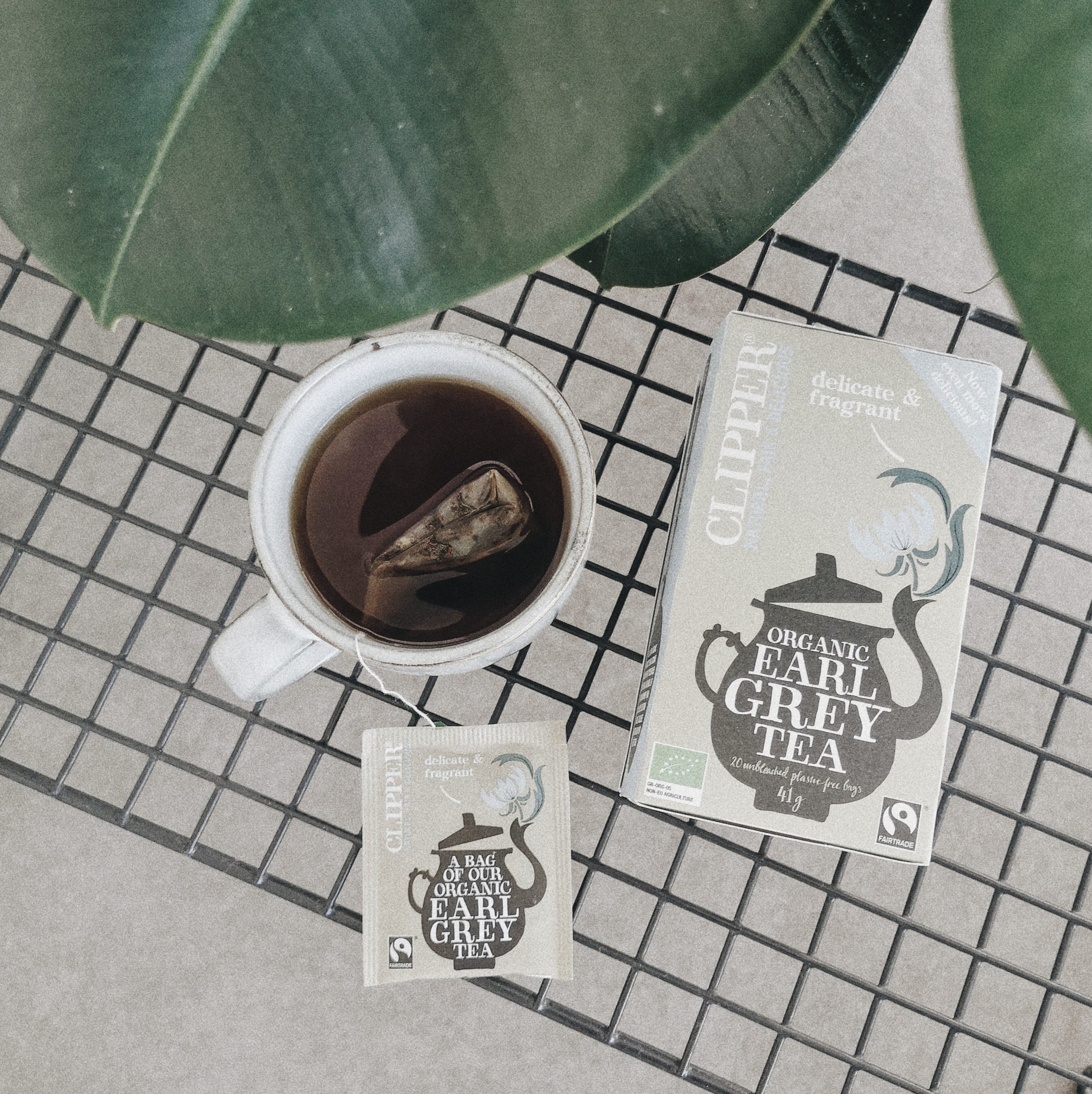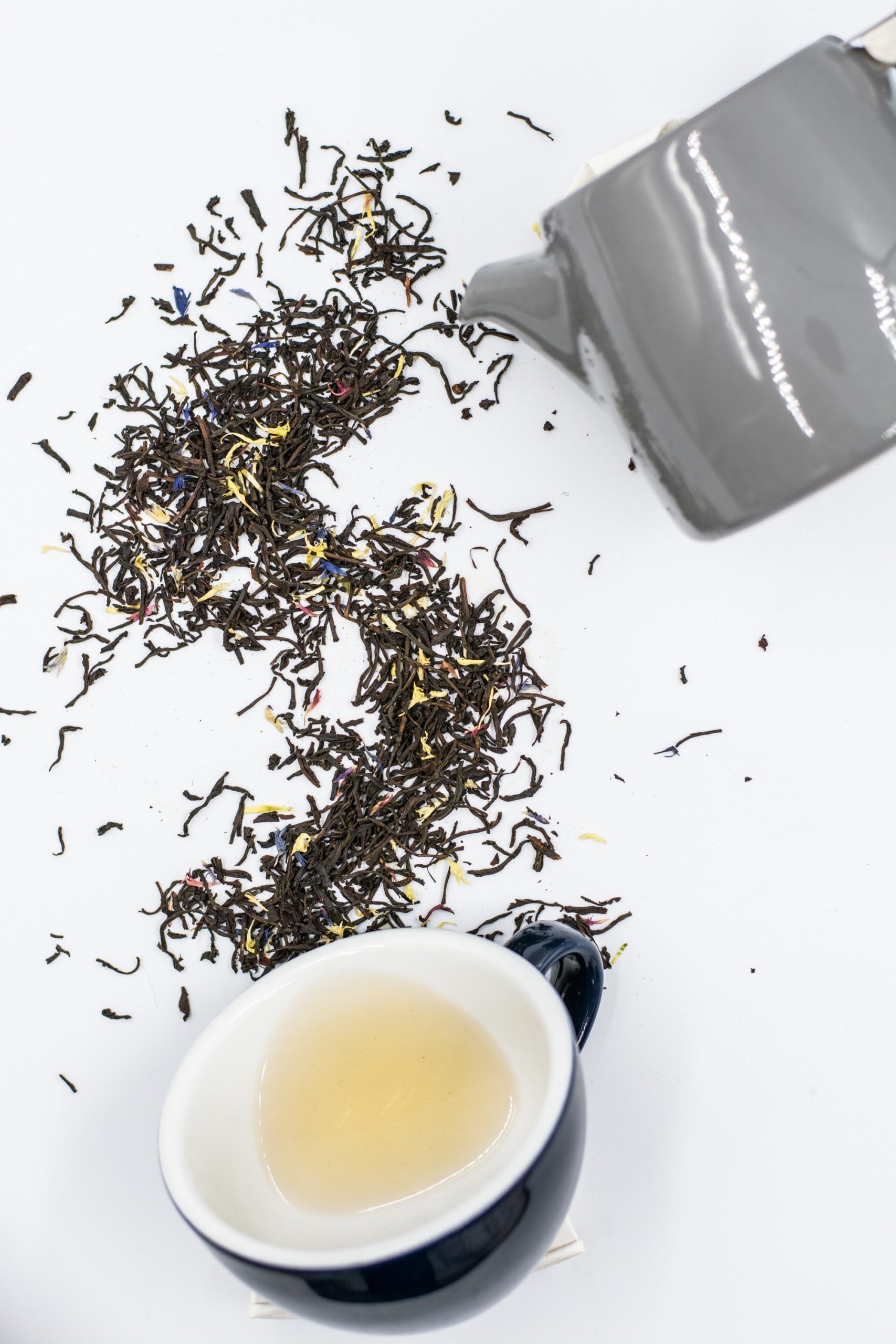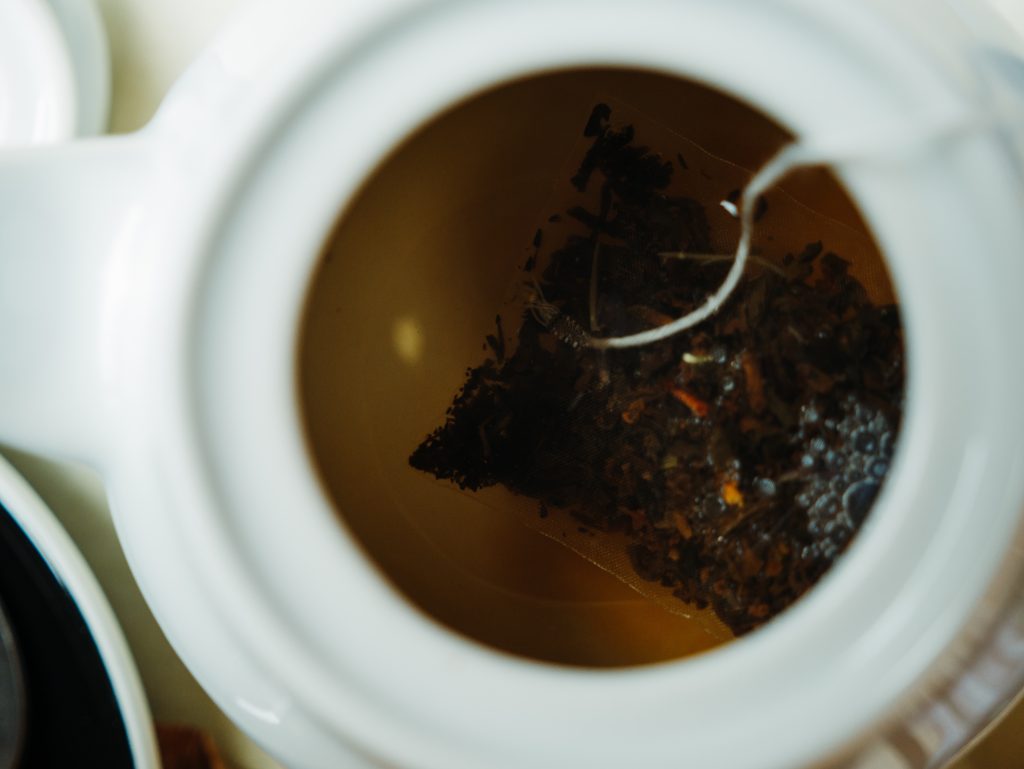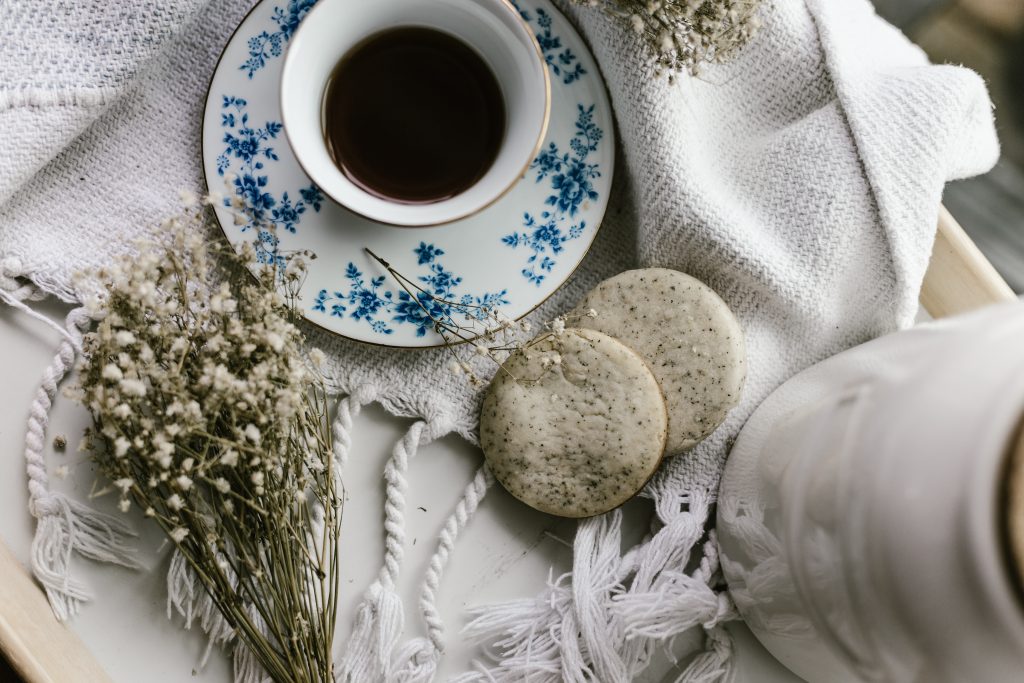One of the most popular types of tea worldwide is Earl Grey Tea. From its regal history intertwined with Charles Grey, the 2nd Earl Grey, to its unique bergamot flavour and health benefits, there’s more to a cup of Earl Grey than meets the eye. The development of Earl Grey tea was significantly influenced by tea blending traditions and craftsmanship from the Far East, which shaped its distinctive character and introduced new flavor profiles to Western tea culture. This article delves into the fascinating history of premium loose-leaf Earl Grey tea, the captivating taste of bergamot orange, its contrast to the commonplace tea bags, its benefits to one’s health, and the art of brewing this classic tea blend.

Photo by Miska Sage on Unsplash
The Fascinating History of Earl Grey Loose Tea
Origin and Legacy of Earl Grey Black Tea
The origin and legacy of Earl Grey black tea have a tale as rich as its flavour. It all began with the blend of Chinese black tea shadowed with bergamot oil. The blend was added to Black tea, and thus, Earl Grey was born. The name, however, comes from Charles Grey, the 2nd Earl Grey.
The Role of Charles, the 2nd Earl Grey in Tea History
Charles Grey, the 2nd Earl Grey, made significant contributions to the history of Earl Grey tea. The traditional Earl Grey blend was named after this former British Prime Minister, hence the name “Earl Grey”. Many tea companies have celebrated the Grey family’s history and their creation of Earl Grey tea, a favoured blend cherished by tea aficionados worldwide.
Evolution of the Classic Earl Grey Tea to Lady Grey Blend
Over time, the classic Earl Grey tea evolved into different variants like the Lady Grey tea. Customized with additional citrus flavours, Lady Grey is a harmonized variation of the traditional Earl Grey, offering a brighter infusion and lighter flavour that teems with the delectable aroma of bergamot orange.
The Unique Bergamot Flavour: Earl Grey Tea’s Signature Taste

The unique flavor of Earl Grey tea comes from the addition of oil extracted from the rind of the bergamot orange. The bergamot orange is believed to be a hybrid of citrus trees native to both the Mediterranean and Southeast Asia, which contributes to its complex flavor profile. The citrus flavor in Earl Grey can also be reminiscent of sweet lime, adding to its distinctive aroma.
Photo by Alice Pasqual on Unsplash
How is Earl Grey Tea Made: The Role of Bergamot Orange
The distinctive flavour of Earl Grey tea largely relies on the bergamot orange. The bergamot oil extracted from the fruit’s rind is infused with a black tea base, providing Earl Grey its signature aromatic profile. Chinese tea masters perfected this fusion, making Earl Grey a globally-loved flavoured tea.
Using Bergamot Oil for a Flavoured Tea Twist
Bergamot oil is the lifeblood of Earl Grey’s unique zest. It gives a pleasant twist to the black tea blend, setting apart Earl Grey with a distinct and invigorating citrus flavour standing out among numerous other tea variants.
Distinguishing the Classic Earl Grey from Earl Green
Though similar in name, Earl Green and the classic Earl Grey offer different tasting experiences. While Earl Grey is characterized by its robust black tea meshed with fragrant bergamot, Earl Grey is a gentler take, swapping black tea leaves with green tea as the base.
Premium Earl Grey Loose Tea Vs. Tea Bags

Photo by Matt Seymour on Unsplash
The Superiority of Loose Leaf Tea Over Tea Bags
The superiority of loose-leaf tea over conventional tea bags is discernible in every brew. Loose-leaf Earl Grey tea has a rich flavour, aroma, and product quality. Opting for the loose variant also supports sustainability, as tea bags often contribute to unnecessary waste.
Why Choose Loose Leaf Earl Grey over Packaged Brews
Choosing loose-leaf Earl Grey over packaged brews allows tea lovers to marvel over the full-bodied taste and aroma unhampered by the confines of a tea bag. Loose tea also guarantees a fresher, more authentic experience, as it’s often sourced more sustainably and responsibly than pre-packaged varieties.
The Role of a Tea Caddy in Preserving Loose Tea
A tea caddy plays a vital role in preserving loose tea. It ensures that each brew from the loose-leaf Earl Grey remains fresh and rich, maintaining this reputed tea blend’s quality, aroma, and taste.
Health Benefits of Drinking Earl Grey Black Tea

Photo by Priscilla Du Preez ???????? on Unsplash
For those seeking a natural way to sweeten their Earl Grey tea without adding many calories, honey can be an excellent choice, enhancing the tea’s flavor while supporting its healthful profile.
The Role of Black Tea Leaves in Promoting Good Health
Black tea leaves have been linked to numerous health benefits. Known for its high antioxidant content, regular consumption of black tea, such as Earl Grey, may reduce the risk of chronic diseases, aid digestion, and improve heart health.
Earl Grey Tea: A Blend of Healthful Delight
Earl Grey tea offers a blend of delightful flavours and an infusion of health benefits. It contains black tea leaves known for potential benefits including stress reduction and boosted immunity, not to mention the promises of bergamot oil that range from mood enhancement to cholesterol control.
Potential Health Benefits of Bergamot Flavoured Beverages
A delightful sip of Earl Grey tea does more than satisfy your palate. Bergamot-flavoured beverages such as Earl Grey may have potential health benefits, including improved heart health and digestion, elevated mood, and even skincare benefits due to the presence of antioxidant-rich bergamot oil.
Who Should Avoid Earl Grey Tea?
While Earl Grey tea is a favorite tea for many around the world, it’s important to remember that this distinctive tea isn’t suitable for everyone. Most people can enjoy a cup of grey tea—whether it’s classic loose leaf tea, convenient tea bags, or a premium earl grey loose tea blend—without any issues. However, there are certain groups who should be mindful of their intake due to the unique properties of bergamot oil and the caffeine content found in this flavored tea.
Who should consider limiting or avoiding Earl Grey tea?
- Pregnant or breastfeeding women: Although a moderate cup of earl grey is generally safe, high amounts of bergamot oil may not be recommended during pregnancy or breastfeeding. The caffeine in black tea and the potential effects of bergamot oil on milk production or uterine stimulation mean it’s best to enjoy this tea in moderation and consult with a healthcare provider if unsure.
- People with citrus allergies: Earl Grey’s signature flavor comes from bergamot oil, a citrus-based ingredient. If you have a known allergy to citrus fruits, it’s wise to avoid earl grey teas, as even small amounts of bergamot can trigger allergic reactions.
- Individuals on certain medications: Bergamot oil can interact with some prescription drugs, including blood thinners, diabetes medications, and blood pressure medicines. If you’re taking any regular medication, check with your doctor before adding earl grey loose or tea bags to your daily routine.
- Those with sensitive stomachs: The citrus notes from bergamot oil can make earl grey a bit more acidic than other black teas. If you’re prone to heartburn, acid reflux, or stomach upset, you may want to limit your intake or opt for a milder tea.
- Children and adolescents: While not toxic, the caffeine and bergamot oil in earl grey tea may not be suitable for younger drinkers. It’s best to keep their consumption to a minimum.
What happens if you drink too much Earl Grey tea?
Enjoying several cups of earl grey loose tea or other flavored teas in a day can lead to an excessive intake of bergamot oil. This may cause symptoms such as muscle cramps, stomach upset, or even allergic reactions. In rare cases, bergamot can interact with medications, so always be cautious if you’re on prescription drugs.
How to Brew the Perfect Cup of Earl Grey Loose Leaf Tea
Getting the Best Out of Black Tea Blend: Brewing Techniques
Brewing the perfect cup of Earl Grey tea requires technique. Getting the best out of the black tea blend requires the right water temperature, loose tea quantity per cup, and steeping time, ensuring the tea extracts its full-bodied flavour and aromatic essence.
Understanding Tea Tasting: Savouring Earl Grey
Understanding the art of tea tasting is vital in truly savouring Earl Grey. Much like wine tasting, tea tasting allows enthusiasts to fully appreciate the tea’s depth of flavour, aroma, and quality — from its first aroma to the lingering aftertaste.
Pairing Earl Grey Tea: Enhancing the Tasting Experience
Enhancing the tasting experience of an Earl Grey blend can be achieved by pairing it with the right food. It perfectly complements breakfast items, pastries, and fruity desserts with its robust and citrusy taste, making every cup a symphony of delightful flavours.
Q: What is the history of Earl Grey tea?
A: Earl Grey is one of the world’s most recognized and popular beverages. It’s named after Charles Grey, the Second Earl Grey, an English aristocrat and also the Prime Minister in the 1830s. He supposedly received the tea as a gift after saving a Chinese man’s son from drowning. The tea was a blend of black tea infused with bergamot to protect the tea from the taste of mould and tar during the long journey from China. A tea master played a key role in perfecting this blend, carefully balancing the black tea and bergamot to achieve the desired flavor profile. Interestingly, though the grey family did have a blend of Earl Grey, there’s no record of the blend they used. The drying process was crucial in preserving the tea’s flavor and quality during transport, ensuring the tea arrived fresh and aromatic.
Q: How is traditional Earl Grey tea made?
A: Earl Grey tea is a blended tea which contains black tea leaves, commonly either Chinese black tea or Ceylon black tea, infused with bergamot, a citrus fruit. Some producers use dried bergamot orange rinds instead of oil to impart the citrus flavor during the drying or blending stage. The citrusy note of bergamot gives Earl Grey its signature flavour.
Q: What should I expect when tasting Earl Grey for the first time?
A: When tasting Earl Grey, you can expect a rich and flavorful cup of black tea with a noticeable note of bergamot. The bergamot provides a zesty, citrusy twist, adding lightness and refreshing quality to the robust black tea base. Some versions of Earl Grey also contain additional ingredients, such as cornflowers or other floral-infused black teas, which provide further complexity.
Q: Are there different versions of Earl Grey?
A: Yes, in addition to the traditional Earl Grey tea blend, there are many popular variations such as Lady Grey (Earl Grey with more bergamot and added lemon and orange), Paris Earl Grey (a fruity Earl Grey with black currant and vanilla), Rooibos Earl Grey (using South African Rooibos instead of black tea), and Emperor Grey (Earl Grey with added rose petals). There are also versions of green tea leaves or oolong instead of black tea.
Q: Can I use any other tea than black for making Earl Grey?
A: Earl Grey is traditionally made with black tea, but variants can be made using green, oolong, or rooibos teas. The decision depends on personal taste. Remember that the type of tea used will dramatically change the flavour of the resulting blend.
Q: What is the Earl Grey tea blend named after?
A: The Earl Grey tea blend is named after Charles Grey, the second Earl Grey, who was the British Prime Minister in the early 19th century. The exact reasons for his name being used are unknown, but one story suggests that a grateful Chinese tea merchant named the tea after Earl Grey following a diplomatic mission.
Q: Are there health benefits to drinking Earl Grey tea?
A: Yes, drinking Earl Grey tea has several potential health benefits. Earl Grey tea contains antioxidant properties which can help to fight off harmful cells in the body. The bergamot in the tea can also have calming effects on people, as well as providing high amounts of vitamin C.
Q: Is the practice of infusing black tea with bergamot inherent to Chinese tea culture?
A: According to some sources, Chinese tea masters constantly experimented, and in that process, they infused all kinds of teas, including black tea, with various fruits and flowers. The concept of infusing black tea with bergamot specifically was likely refined over time, becoming what we know as Earl Grey today.
Q: What is meant by ‘cup of Earl Grey’?
A: A ‘cup of Earl Grey’ refers to a cup of tea made with the Earl Grey blend, typically black tea leaves infused with oil extracted from the rind of the bergamot orange, a citrus fruit.
Q: What is the relationship between the English tea tradition and Earl Grey?
A: The English have long been known for their love of tea, and Earl Grey has a particular place in that tradition. Named after an English Earl, Earl Grey is a quintessentially English tea, often associated with refinement and elegance. In fact, it is a popular choice for traditional English afternoon tea.

